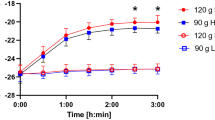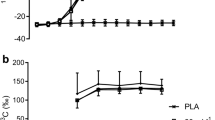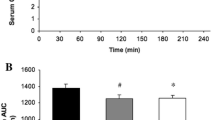Summary
We studied rates of exogenous carbohydrate (CHO) oxidation during 90 min of cycling exercise in trained cyclists exercising at 70% of maximal oxygen consumption (VO2max) when they ingested glucose, sucrose, or glucose polymer solutions at concentrations of 7.5%, 10% or 15%. Drinks were labelled with [U-14C]glucose or sucrose and were ingested at a rate of 100 ml · 10 min−1. Rates of oxidation of the ingested CHO were calculated from the specific radio-activity of the labelled CHO, expired14CO2 and carbon dioxide output (VCO2). Total CHO oxidation, determined from oxygen consumption andVCO2 was not influenced by CHO type or concentration. Gastric emptying (P=0.01) and the rate of exogenous CHO oxidation (P=0.028) was greatest for the glucose polymer solutions, and least for glucose. Although gastric emptying (P=0.006) decreased with increasing CHO concentration, CHO delivery to the intestine and exogenous CHO oxidation increased linearly with increasing CHO concentration. The percentage of the CHO delivered to the intestine that was oxidized ranged from 30.0% for 7.5% CHO to 38.1% for 15% CHO. Our results indicated that the rate of gastric emptying for CHO was not controlled to provide a constant rate of energy delivery as is commonly believed and that factors subsequent to gastric emptying limit the rate of exogenous CHO oxidation from the ingested solution.
Similar content being viewed by others
References
Box GEP, Hunter WG, Hunter JS (1978) Statistics for experimenters. Whiley, New York, pp 258–279
Brandenberger G, Candas V, Follenius M, Libert JP, Kahn JM (1986) Vascular fluid shifts and endocrine responses to exercise in the heat. Eur J Appl Physiol 55:123–129
Candas V, Libert JP, Brandenberger G, Sagot JC, Amoros C, Kahn JM (1986) Hydration during exercise. Effects on thermal and cardiovascular adjustment. Eur J Appl Physiol 55:113–122
Cochran WG, Cox G (1957) Experimental Designs, 2nd edn. Wiley, New York, pp 477–478
Coggan AR, Coyle EF (1987) Reversal of fatigue during prolonged exercise by carbohydrate infusion or ingestion. J Appl Physiol 63:2388–2395
Coggan AR, Coyle EF (1988) Effect of carbohydrate feedings during high-intensity exercise. J Appl Physiol 65:1703–1709
Coggan AR, Coyle EF (1989) Metabolism and performance following carbohydrate ingestion late in exercise. Med Sci Sports Exerc 21:59–65
Consalazio CR, Johnson RE, Pecora LT (1963) Physiological measurements of metabolic function in man. McGraw, New York, pp 72–87
Costill DL (1990) Gastric emptying of fluids during exercise. In: Gisolfi CV, Lambs DR (eds) Perspectives in exercise science and sports medicine, vol. 3. Fluid homeostasis during exercise. Benchmark Press, Indianapolis, pp 97–121
Costill DL, Saltin B (1974) Factors limiting gastric emptying during rest and exercise. J Appl Physiol 37:679–683
Costill DL, Bennett A, Branham G, Eddy D (1973) Glucose ingestion at rest and during prolonged exercise. J Appl Physiol 34:764–769
Coyle EF, Hamilton M (1990) Fluid replacement during exercise: Effects on physiological homeostasis and performance. In: Gisolfi CV, Lambs DR (eds) Perspectives in exercise science and sports medicine, vol. 3. Fluid homeostasis during exercise. Benchmark Press, Indianapolis, pp 281–303
Coyle EF, Coggan AR, Hemmert MK, Ivy JL (1986) Muscle glycogen utilization during prolonged strenuous exercise when fed carbohydrate. J Appl Physiol 61:165–172
Dill DB, Costill DL (1974) Calculation of percentage change in volumes of blood, plasma, and red cells in dehydration. J Appl Physiol 37:247–248
Foster C, Costill DL, Fink WJ (1980) Gastric emptying characteristics of glucose and glucose polymer solutions. Res Q Exerc Sport 51:299–305
Greenleaf JE, Convertino VA, Manyseth GR (1979) Plasma volume during stress in man. J Appl Physiol 47:1031–1038
Guezennec CY, Satabin P, Duforez F, Merino D, Peronnet F, Koziet J (1989) Oxidation of corn starch, glucose, and fructose ingested before exercise. Med Sci Sports Exerc 21:45–50
Hawley JA, Dennis SC, Laidler BJ, Bosch AN, Noakes TD, Brouns F (1991) High rates of exogenous carbohydrate oxidation from starch ingested during exercise. J Appl Physiol 71:1801–1806
Hunt JN, Pathak JD (1960) The osmotic effects of some simple molecules and ions on gastric emptying. J Physiol 154:245–269
Hunt JN, Stubbs DF (1975) The volume and energy content of meals as determinants of gastric emptying. J Physiol 245:209–215
Massicotte D, Peronnet F, Brisson G, Bakkouch K, Hillaire-Marcel C (1989) Oxidation of a glucose polymer during exercise: comparison with glucose and fructose. J Appl Physiol 66:179–183
Massicotte D, Peronnet F, Brisson G, Boivin L, Hillaire-Marcel C (1990) Oxidation of exogenous carbohydrate during prolonged exercise in fed and fasted conditions. Int J Sports Med 11:253–258
Neufer PD, Costill DL, Fink WJ, Kirwan JP, Fielding RA, Flynn MG (1986) Effects of exercise and carbohydrate composition on gastric emptying. Med Sci Sports Exerc 18:658–662
Noakes TD, Myburgh KH, Schall R (1990) Peak treadmill running velocity during theV 2max test predicts running performance. J Sport Sci 8:35–45
Noakes TD, Rehrer NJ, Maughan RJ (1991) The importance of gastric volume in regulating gastric emptying. Med Sci Sports Exerc 23:307–313
Rehrer NJ (1990) Limits to fluid availability during exercise. Thesis, University of Vrieseborch, Harlem, pp 1–239
Rehrer NJ, Beckers E, Brouns F, ten Hoor F, Saris WHM (1989) Exercise and training effects on gastric emptying of carbohydrate beverages. Med Sci Sports Exerc 21:540–549
SAS Institute Inc (1985) SAS users guide: statistics version 5th edn. SAS Institute, Cary, N.C., pp 433–506
Schedl HP, Miller D, White D (1966) Use of polyethylene glycol and phenol red as unabsorbed indicators for intestinal absorption studies in man. Gut 7:159–163
Scherrer S, Haldimann B, Kupfer A, Reubi F, Bircher J (1978) Hepatic metabolism of aminopyrine in patients with chronic renal failure. Clin Sci Mol Med 54:133–140
Sole CC, Noakes TD (1989) Faster gastric emptying for glucosepolymer and fructose solutions than for glucose in humans. Eur J Appl Physiol 58:605–612
Wolfe RR, Wolfe MH, Nadel ER, Shaw JHF (1984) Isotopic determination of amino acid-urea interactions in exercise in humans. J Appl Physiol 56:221–229
Author information
Authors and Affiliations
Rights and permissions
About this article
Cite this article
Moodley, D., Noakes, T.D., Bosch, A.N. et al. Oxidation of exogenous carbohydrate during prolonged exercise: the effects of the carbohydrate type and its concentration. Europ. J. Appl. Physiol. 64, 328–334 (1992). https://doi.org/10.1007/BF00636220
Accepted:
Issue Date:
DOI: https://doi.org/10.1007/BF00636220




